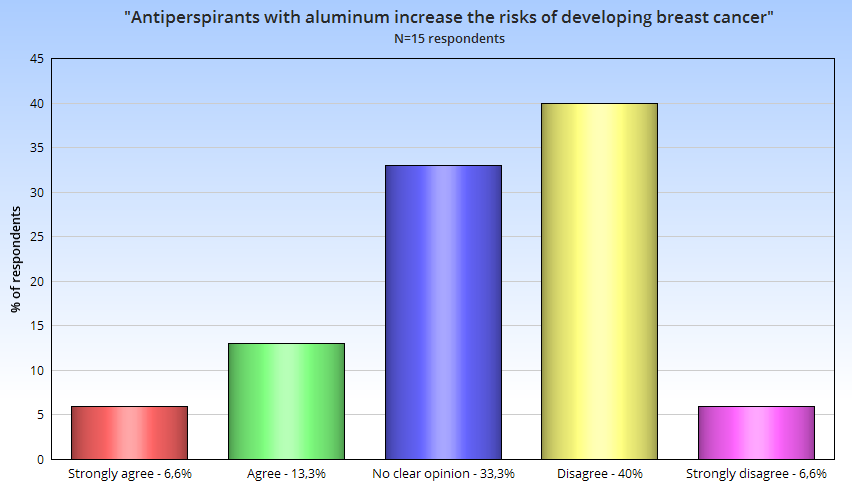Introduction
There is a myth about the use of antiperspirants, especially aluminum-containing ones, as a risk factor for breast cancer. Concerning the rationale for choice, the myth requires close attention due to its possible contributions to bullying related to hygiene issues and distracting the at-risk population from actual precautions. This paper explains this belief’s perceptions by social media users and proposes a social media strategy to correct the misconception.
The Misconception and Science
The misconception can be traced back to a hypothesis that found no confirmation in subsequent studies. In 2004, Philippa Darbre studied twenty breast tumors and found increased levels of parabens in four of them (Al-Eessa and Al-Attar 66). It gave rise to an assumption that antiperspirants’ ingredients could promote breast cancer by maximizing a person’s exposure to estrogen (Al-Eessa and Al-Attar 66). Notably, this proposition remained purely hypothetical and did not find support.
There are online resources that misinterpret or misrepresent scientific research, thus leading to the myth’s proliferation. As per Al-Eessa and Al-Attar, around 11% of adult women assume that antiperspirants can cause cancer (66). Aluminum blocks sweat from entering the surface of the skin (Kulkarni et al. 1). In their study, Kulkarni et al. demonstrate that 29.4% of topic-specific resources for English-speaking populations mention the “increased risk” of cancer due to exposure to aluminum (7). Aside from omitting systematic reviews that show no statistically significant correlations between the disease and antiperspirant/aluminum exposure, such resources promote commercial interests (Kulkarni et al. 7). Kulkarni et al. reveal that most websites that misrepresent the health risks of antiperspirants are run by the producers of natural skincare products, which suggests the use of customer intimidation as a marketing strategy (7). Thus, there are commercial parties interested in spreading the myth.
Researchers and authoritative organizations reject antiperspirants’ role in promoting breast tumors. In their study of 274 breast cancer patients and 200 healthy subjects used as a control group, Peyman and Vaghar report no correlational data that would suggest connections between receiving the diagnosis and using antiperspirants (1345). Both groups were carefully surveyed in terms of the type of product utilized, antiperspirant brand preferences, the combination of armpit shaving and applying antiperspirants, and application patterns. Nevertheless, none of the factors was associated with the increased prevalence of disease (Peyman and Vaghar 1345). Authoritative organizations, including the Susan G. Komen for the Cure and the American Cancer Society, clearly report the absence of relationships between antiperspirants’ regular use and breast cancer risks (Kulkarni et al. 7). Therefore, trustworthy parties did not make statements that would support the myth.
Survey Results
Explanation of the Survey
The link to a 3-question Google Forms survey was posted to a Reddit group devoted to skincare and hygiene. The following questions were included:
- Q1. To what extent do you agree that the use of aluminum-containing antiperspirants increases the risks of developing breast cancer?
- Q2. Have you ever heard of research that demonstrates antiperspirants’ contributions to breast cancer?
- Q3. Where have you encountered claims that antiperspirants can cause breast cancer? List all types of sources, including personal communication.
Results
The findings suggest that the misconception is rather popular among common Internet users. Among the 15 respondents, more than 30% struggle with deciding whether the statement is true, and almost 20% find it correct or absolutely correct (see fig.1). Regarding encounters, 60% have heard of “research” to support the statement, and almost 70% report experiences with this belief during conversations with people they know or using online resources and mass media (see table 1). Thus, the belief, especially the possibility that it might be true, comes from various sources, and public education is required.

Table 1. Q2/Q3 Summarya
Note: The table provides a summary of the respondents’ acquaintance with research that promotes the misconception (Q2) and the types of sources that promote the misconception (Q3).
Communicating Science: A Social Media Strategy
To correct the stereotype, it is possible to implement a social media strategy on Facebook. Firstly, in collaboration with the American Cancer Organization’s (ACO) official group, it is necessary to create five illustrated posts that list the confirmed contributors to breast cancer and highlight the lack of evidence for hygiene products’ role in it. The next step is to launch the #antiperspirantsdonotcausecancer hashtag and encourage large body product manufacturers, including Procter&Gamble, Unilever, and Palmolive, to repost the ACO’s statement and promote the hashtag. Thirdly, the three corporations will announce a creative video contest in their official groups. Each participant will film a 30-second music video that dispels the myth in an original way and post it to the specially created group with the aforementioned hashtag. The group’s administrators will choose the best ten videos and create a poll to determine only three winners. These three contestants will receive gift baskets with body care products from the corporations.
Conclusion
The research project promoted a series of takeaways, including social media users’ significant chances of encountering the belief that antiperspirants can increase the risks of breast cancer. In spite of trustworthy cancer research organizations’ clear statements to dispel the myth, people still hear it from relatives, content creators, and, sometimes, healthcare professionals. Acknowledging this problem is essential to prevent baseless fears and redirect at-risk populations’ attention to relevant self-care.
Works Cited
Al-Eessa, Raghad A., and Wafaa M. A. Al-Attar. “Breast Cancer Knowledge, Attitude, Concepts and Related Effect of Education among Iraqi Women in Baghdad.” International Journal of Science and Research, vol. 17, no. 5, 2018, pp. 60-67. Web.
Kulkarni, Shibani, et al. “A Comprehensive Analysis of How Environmental Risks of Breast Cancer are Portrayed on the Internet.” American Journal of Health Education, vol. 49, no. 4, 2018, pp. 1-13.
Peyman, Akram, and Mohammad Islami Vaghar. “Relationship between the Use of Antiperspirants Containing Aluminum with Breast Cancer in Patients Referred to Selected Hospitals of Tehran University of Medical Sciences in 2013.” Pakistan Journal of Medical and Health Sciences, vol. 14, no. 2, 2020, pp. 1345-1349. WHO EMRO.